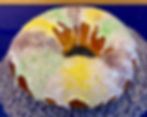Mardi Gras King Cake -- What's with the Plastic Baby?
- Laurie Schive
- Feb 16, 2021
- 3 min read
Updated: Feb 14, 2023

On February 1st, I turned the page of my Bread Bakers' Guild of America (BBGA) calendar and saw a beautiful photo of King Cake, baked by Guild member Megan Forman of Gracious Bakery in New Orleans. I'd lived on the Gulf Coast for a few years, so had eaten quite a few King Cakes in the weeks before Mardi Gras. But I hadn't made any at our bakery. I studied the colorful gold, purple and green sanding sugar on a bed of white icing topping the King Cake. Yup, just what we needed to brighten up our snowy winter and bring a bit of New Orleans to New Hampshire.

King cake is a brioche-style bread, and can have a variety of fillings. I go with cream cheese or pecan, but I've seen everything from traditional cinnamon to strawberry, lemon, and amaretto. The dough is rolled out into a thin rectangle, filling is spread inside, then it's rolled up and shaped into a ring for baking. The cake is finished with a sweet flat icing and sparkling sugar in the traditional Mardi Gras colors: purple (for justice), green (for faith) and gold (for power).

The King Cake tradition started in Europe as a celebration of Epiphany. In France, a Galette des Rois ("cake of kings") is served on January 6th to celebrate Epiphany--the arrival of the three kings twelve days after Christmas. French bakers would insert a bean, or fève, inside the galette. Whoever got the bean was king for the day.
French Catholics who settled in Louisiana continued the king cake tradition. Commercial bakeries started offering the cake not just on January 6th, but for the whole season from Epiphany to Shrove Tuesday (or Mardi Gras in French)--the last day to celebrate before the fasting season of Lent begins on Ash Wednesday. My Italian mother called Mardi Gras "Fat Tuesday". It was the one day of the year we knew she'd let us kids eat donuts for breakfast.

So, how did we go from beans to babies in King Cake? Some think that the plastic baby represents the Baby Jesus, but it actually was the brainchild of a New Orleans baker named Donald Entringer, Sr.
Entringer ran McKenzie's Pastry Shoppe in New Orleans. In the 1930's, a Carnival krewe had asked him to make king cakes with prizes inside instead of the traditional bean. While pondering what he could bake inside the cake, Entringer ran into a traveling salesman who had with him little porcelain dolls from France called "Frozen Charlottes." They were small enough to fit in a dollhouse, but the salesman wasn't having much luck selling them and had an oversupply he wanted to get rid of. According to legend, the salesman suggested Entringer use them as the prize in king cakes. Entringer loved the idea and got approval from the New Orleans health department to bake the porcelain babies into the king cakes. Entringer eventually ran out of porcelain babies, but found a supplier of plastic babies in the French Quarter.
The tradition started by McKenzie's is still going strong. An authentic New Orleans king cake now always comes with a plastic baby. This year, I included a baby with the king cake so customers could place it inside the cake if they wanted. But before Mardi Gras next year, I'm going to give a call to the New Hampshire Health Department...
